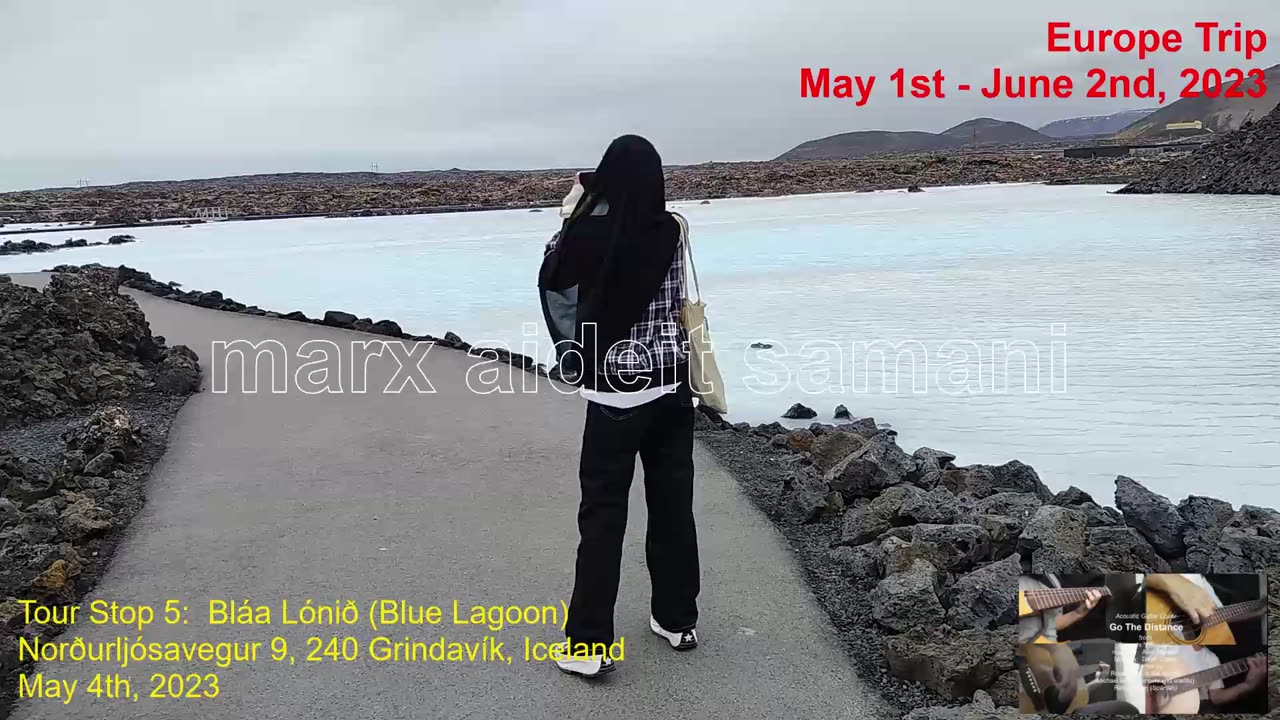Premium Only Content

May 4th, 2023 Bláa Lónið (Blue Lagoon), Norðurljósavegur 9, 240 Grindavík, Iceland
May 1st, 2023 - June 2nd, 2023: Europe Trip
May 4th, 2023 Bláa Lónið (Blue Lagoon), Norðurljósavegur 9, 240 Grindavík, Iceland
Segment 17d May 4th, 2023 Tour Stop 5: Bláa Lónið (Blue Lagoon), Norðurljósavegur 9, 240 Grindavík, Iceland
Bláa lónið (The Blue Lagoon)
The Blue Lagoon (Icelandic: Bláa lónið [ˈplauːa ˈlouːnɪθ]) is a geothermal spa in southwestern Iceland. The spa is located in a lava field 5 km (3.1 mi) from Grindavík and in front of Mount Þorbjörn on the Reykjanes Peninsula, in a location favourable for geothermal power, and is supplied by water used in the nearby Svartsengi geothermal power station. The Blue Lagoon is approximately 20 km (12 mi) from Keflavík International Airport, and is one of the most visited tourist attractions in Iceland.
The water's milky blue hue is due to its high silica content. The silica forms soft white mud on the bottom of the lake which bathers rub on themselves. The water is also rich in salts and algae.
The water temperature in the bathing and swimming area of the lagoon averages 37–39 °C (99–102 °F). Guests are required to shower in the nude prior to using the geothermal spa. The communal showers are split up by gender. Children age 8 and under are only allowed entry with the use of arm floaters, provided free of charge. The lagoon is not suitable for children under the age of 2 years. The lagoon is accessible for wheelchair users with a ramp that extends into the water and a shower chair. There is also a private changing room available for those with special needs.
The lagoon is man-made. The water is a byproduct from the nearby geothermal power plant Svartsengi where superheated water is vented from the ground near a lava flow and used to run turbines that generate electricity. After going through the turbines, the steam and hot water pass through a heat exchanger to provide heat for a municipal water heating system. Then the water is fed into the lagoon.
The rich mineral content is provided by the underground geological layers and pushed up to the surface at a pressure of about 1.2 MPa (12 bar) and temperature of 240 °C (464 °F), which is used by the powerplant. Because of its high mineral concentration, the water cannot be recycled, and must be disposed of in the nearby landscape, a permeable lava field that varies in thickness from 50 to 100 cm (20 to 40 in). After the minerals have formed a deposit, the water reinfiltrates the ground, but the deposits render the ground impermeable over time, so the plant needs to continuously dig new ponds in the nearby lava field.
The water renews every two days. The average pH is 7.5 and the salt content is 2.5%. Very few organisms live in the water apart from some blue-green algae. Despite the water not being artificially disinfected, it contains no fecal bacteria, environmental bacteria, fungi, or plants.
-
 16:30
16:30
Brad Polumbo
6 hours agoCreepy “trans” star Lilly Tino has learned NOTHING! | NORMAL GAYS react
1.54K1 -
 8:00
8:00
Freedom Frontline
2 hours agoJake Tapper Just HUMILIATED Tim Walz on CNN With Simple Questions
1.59K2 -
 1:40:43
1:40:43
Benny Johnson
3 hours ago🚨White House Press Briefing LIVE Right Now: Karoline Leavitt Reacting to Massive New Trump News
36.8K28 -
 1:20:47
1:20:47
Russell Brand
3 hours agoRoyal Cover-Up? The Final Chapter of Diana’s Death - SF616
113K39 -
 3:35:49
3:35:49
Right Side Broadcasting Network
5 hours agoLIVE REPLAY: White House Press Secretary Karoline Leavitt Holds a Press Briefing - 7/17/25
104K29 -
 1:16:33
1:16:33
Nikko Ortiz
2 hours agoBuilding Your Night Rifle
25.4K -
 2:06:45
2:06:45
Side Scrollers Podcast
4 hours agoAstronomer CEO/HR Scandal, NPR/PBS DEFUNDED, Mortal Kombat II Trailer REACTION | Side Scrollers
10.7K1 -
 9:10
9:10
Tactical Advisor
5 days agoNEW Ported CZ P-10C (FIRST LOOK)
8.71K -
 19:06
19:06
ArturRehi
12 hours agoLet's Analyse the Estonian Army: Are they ready for WAR WITH RUSSIA? | In-depth Analysis
5.65K -
 LIVE
LIVE
Viss
3 hours ago🔴LIVE - How to Win The Battleground with Tactics, Precision, & Knowledge!
160 watching